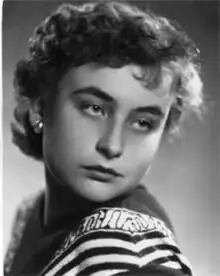Judita Vaičiūnaitė | |
|---|---|
 | |
| Born | July 12, 1937 Kaunas, Lithuania |
| Died | February 11, 2001 (aged 63) Vilnius, Lithuania |
| Occupation | Poet |
| Alma mater | Vilnius University |
| Subject | Mythology, Vilnius, the lives of women |
Judita Vaičiūnaitė (July 12, 1937 – February 11, 2001) was a Lithuanian writer. Best known for her poetic exploration of urban settings and mythological women, she is one of Lithuania's most famous 20th-century poets.[1][2][3]
Early life and education
Judita Vaičiūnaitė was born in 1937 in Kaunas, Lithuania.[4][5] Her father was a professor of psychiatry, and her mother was a nurse. She was particularly close with her sister Dalia.[4]
After World War II, she moved to Vilnius with her family.[3] There, she studied at Vilnius University, graduating in 1959.[6] Vaičiūnaitė would live in Vilnius for the rest of her life, making the city a central subject of her work.[1][4]
Career
Vaičiūnaitė's first poetry collection, Pavasario akvarelės ("Spring Watercolors"), was published in 1960.[2] She went on to publish new collections frequently, producing more than 20 books of poetry.[2][6] She also wrote fairy tales and poems for children.[2][4]
Vaičiūnaitė worked as an editor for several literary journals in Lithuania.[6] She also completed translations of other poets into Lithuanian, notably the work of Anna Akhmatova.[7][8] In 1978, she was named the laureate of the Lithuanian Poetry Spring festival.[4]
In 1996, she was awarded the Baltic Assembly Prize for Literature, the Arts and Science for her collection Žemynos vainikai ("Wreaths of Zemyna").[4] That year, she published the memoir Vaikystės veidrody, a series of essays about her own life.[4][9] She was issued the Order of the Lithuanian Grand Duke Gediminas in 1997, and the Lithuanian Writers' Union Prize in 2000.[6]
Writing
Vaičiūnaitė's poetry dealt with a wide range of subjects and themes, including Lithuanian and Greek mythology, modern jazz, history, and contemporary city life.[1][3][10] Her urban-centered poetry, frequently set in Vilnius' Old Town, is perhaps her best known.[1][2] It came at a time when most other Lithuanian poets were from the countryside and focused on the natural world in their work.[11][12] She also incorporated the city's multicultural history into her poems.[3][13]
She frequently employed dramatic monologue in her work, often from the point of view of female historical and mythological figures.[1][13] Her poetry was influenced by the neo-romantic work of Salomėja Nėris, the first prominent Lithuanian woman poet.[14] Alongside Marcelijus Martinaitis, Sigitas Geda, and others, she was part of a generation that quietly revolutionized Lithuanian poetry as dissatisfaction grew with Soviet rule, but the neo-romantic strains persisted.[3][4][13][9]
Vaičiūnaitė was a highly independent single mother, but she was also convinced of the importance of romantic love. She wrote with a feminist realism, narrating the lives of single women in the city.[4][3][11]
Death and legacy
Judita Vaičiūnaitė died in Vilnius in 2001.[4][5][15] A 2010 posthumous collection of selections from her work, Kristalas: Poezijos Rinktinė, was published by the Lithuanian Writers' Union.[6][13] In 2018, a collection of her work in English translation was published as Vagabond Sun: Selected Poems.[3]
A monument to her stands near the Church of St. Catherine in Vilnius.[4]
Selected works
Poetry
- Pavasario akvarelės (1960)
- Kaip žalias vynas (1962)
- Per saulėtą gaublį (1964)
- Vėtrungės (1966)
- Po šiaurės herbais (1968)
- Žiemos lietus (1987)
- Žemynos vainikai (1995)
- Seno paveikslo šviesa (1998)
- Debesų arka (2000)
- Kristalas: Poezijos Rinktinė (posthumous, 2010)
Plays
- Pavasario fleita (collection, 1980)
Memoir
- Vaikystės veidrody (1996)
References
- 1 2 3 4 5 "Judita Vaiciunaite". All Poetry. Retrieved 2021-03-15.
- 1 2 3 4 5 "Judita Vaičiūnaitė". Vilnius Review. 2017-06-19. Retrieved 2021-03-15.
- 1 2 3 4 5 6 7 Tsai, Jennifer Lee (2019-03-02). "On 'Vagabond Sun: Selected Poems' by Judita Vaičiūnaitė, translated by Rimas Uzgiris (Shearsman, 2018)". Ambit. Archived from the original on 2019-10-30. Retrieved 2021-03-15.
- 1 2 3 4 5 6 7 8 9 10 11 Bernotienė, Gintarė. "Vaičiūnaitė". Šaltiniai (in Lithuanian). Retrieved 2021-03-15.
- 1 2 North, Michael (2016). The Baltic : a history. Kenneth Kronenberg. Cambridge. ISBN 978-0-674-42604-7. OCLC 1124433712.
{{cite book}}: CS1 maint: location missing publisher (link) - 1 2 3 4 5 "from Crystal by Judita Vaičiūnaitė". Asymptote. Retrieved 2021-03-15.
- ↑ Urban semiotics : the city as a cultural-historical phenomenon. I. A. Pilʹshchikov. Tallinn. 2015. ISBN 978-9985-58-807-9. OCLC 951558037.
{{cite book}}: CS1 maint: location missing publisher (link) CS1 maint: others (link) - ↑ Venclova, Tomas; Hinsey, Ellen (2014). "Meetings with Anna Akhmatova". New England Review. 34 (3/4): 170–182, 383, 390. doi:10.1353/ner.2014.0039. S2CID 176956687.
- 1 2 Transitions of Lithuanian postmodernism : Lithuanian literature in the post-Soviet period. Mindaugas Kvietkauskas. New York: Rodopi. 2011. ISBN 978-94-012-0728-7. OCLC 785782275.
{{cite book}}: CS1 maint: others (link) - ↑ Silbajoris, Rimvydas (1980). "Lithuanian literature". The Columbia Dictionary of Modern European Literature (2nd ed.). New York: Columbia University Press.
- 1 2 Uzgiris, Rimas (2016-04-18). ""Unexpected Vistas": Rimas Uzgiris Translates Judita Vaičiūnaitė". AGNI Magazine. Retrieved 2021-03-15.
- ↑ Silbajoris, Rimvydas (Winter 2002). "Debesu arka". World Literature Today. 76 (1): 170. doi:10.2307/40157122. JSTOR 40157122.
- 1 2 3 4 Uzgiris, Rimas (2017-06-19). "To Gaze Through Clouds of Dust". Vilnius Review. Retrieved 2021-03-15.
- ↑ Uzgiris, Rimas (2016-03-15). "Translating Two Neo-Romantic Poems by Judita Vaičiūnaitė". World Literature Today. Retrieved 2021-03-15.
- ↑ Lithuania : in her own words : an anthology of contemporary Lithuanian writing. Laima Sruoginis. Vilnius: Tyto alba. 1997. ISBN 9986-16-054-5. OCLC 40545537.
{{cite book}}: CS1 maint: others (link)